Marketing has always been in flux. That’s nothing new. What does feel a little novel is the speed at which AI search, specifically LLMs, have become a focal point.
As a result, the marketing landscape is ripe with optimize-or-get-left-behind energy.
If it all makes your head swim a little bit, you’re not alone. A lot of our clients are concerned about falling behind, keen on integrating tactics into their strategies, and a little unclear on how to optimize for AI search.
That’s why I wanted to take a step back and lay things out in simple terms. Specifically, I want to help build a foundational understanding of how marketers can adapt to LLM-powered search, which is really what people are talking about today when they say “AI search.”
At the business level, it’s important to understand a few things:
- How LLMs generate answers
- Major factors that drive visibility in LLM answers today
- Non-spammy tactics brands can use to grow visibility
- How to measure LLM performance for your brand
Thinking about LLM SEO vs. Traditional SEO
Before we get into our agenda, let’s take a second for something that needs to be said: Traditional SEO is still the breadwinner in today’s marketing mix.
With so much buzz about AI, it can create a false sense of urgency to divert focus to optimizing for LLM answers, which some marketers call AEO — i.e. answer engine optimization.
Please note that I’m not taking a stand on using AEO as an industry term, but it’s an acronym that you might run into! There’s also SEO (search everywhere optimization), GEO (generative engine optimization), ASO (AI search optimization — not to be confused with app store optimization), and AIO (AI optimization — another confusing one given Google’s AI Overviews go by the same name!).
So even knowing what to call it is a little exhausting!
But this isn’t an “AEO vs. SEO” situation.
If brands don’t focus on SEO today, they’ll miss out on a vastly larger pool of immediate opportunity. In fact, an analysis of search engine vs. LLM usage by SparkToro finds that there are about 14 billion Google searches every day versus 37.5 million ChatGPT user prompts.
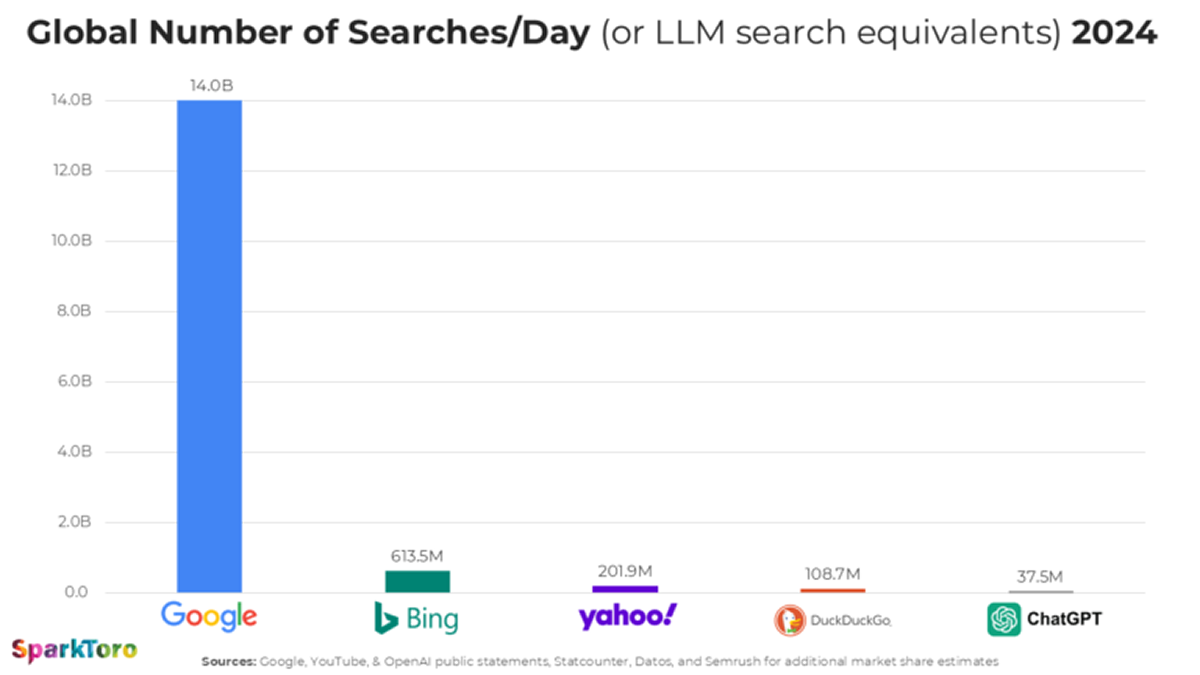
On the other hand, brands that don’t start positioning themselves for LLM visibility today may fall behind tomorrow.
Luckily, there’s a lot of overlap in LLM search optimization and traditional SEO optimization, which we’ll get into as we talk tactics.
How do LLMs generate responses?
LLMs fall into a category of AI known as Machine Learning, which deals with pattern recognition in data. LLMs are, in essence, word calculators. Or if you’re one for a little levity, like myself, you can think of them as “spicy autocomplete.”
They are word-pattern-recognizing engines that calculate the probability of the word that should come next. The pattern-recognition is based on two things:
- The previous words used in the prompt
- Similar patterns of words used across whichever sources that LLM is using
LLMs source answers in a variety of ways. Each LLM has its own proprietary mix that can include any of the following:
- Pre-ingested and pre-processed “training materials” which often include books, media/news outlets, scientific journals, wiki-data sources, UGC like Reddit and Youtube, and prioritized webpages from “quality” sites.
- The live web by using MCP to “search” sources via an API.
- MCP (Model Context Protocol) is a tool that enables LLMs to interact with external data.
- These MCP servers usually prioritize the same “quality” domains used in their training materials, especially Google and Bing indexes.
- Users can write prompt instructions in a file (“planning mode”, e.g. CLAUDE.md) that is set on a project level or global account level, making the instructions prerequisite for any queries that are run in that account or project. (So you don’t have to pour paragraphs of universal context into every prompt. Plus, you can add discrete steps to the process!)
- Live feedback where humans respond to LLM answers in real time, creating a “feedback loop” aimed at improving results - and potentially, related searches - for other users.
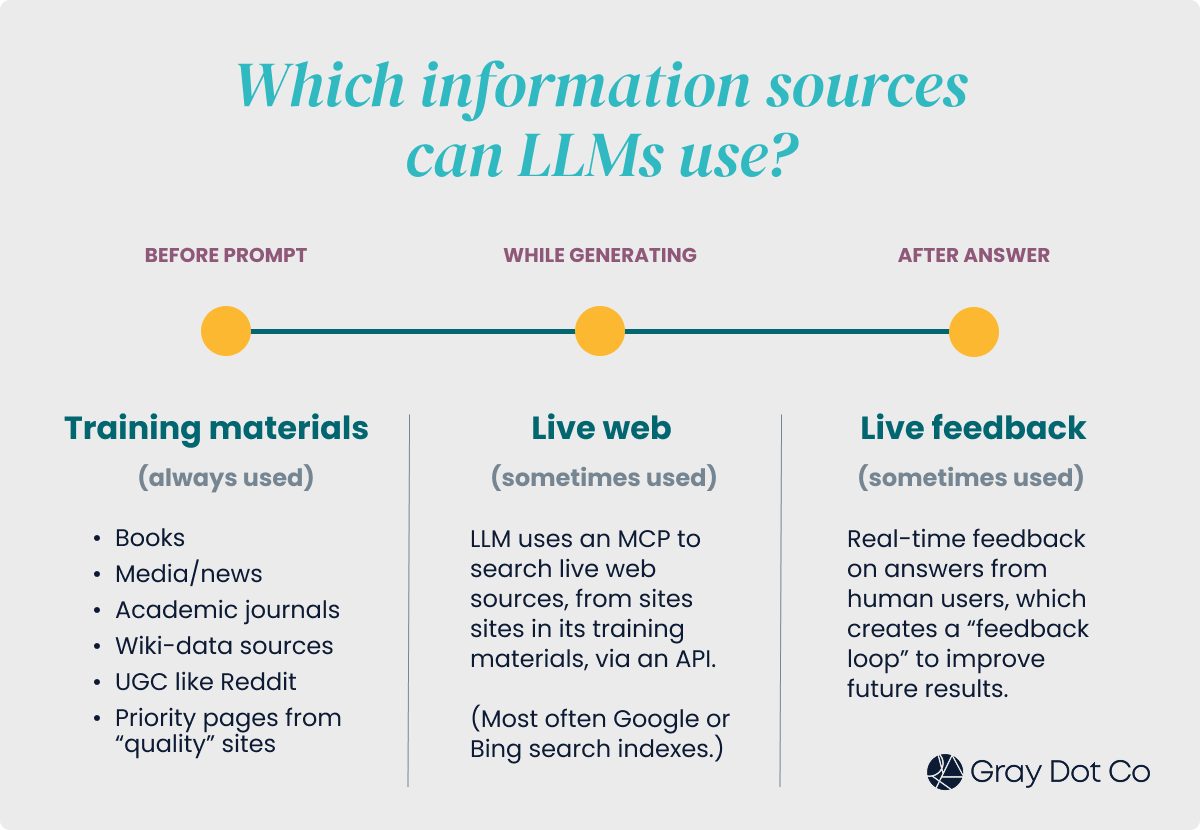
So when someone asks an LLM like ChatGPT for advice or recommendations, all the user is really getting are the words most likely to occur related to the words in a prompt.
For example, someone might ask ChatGPT what the five best restaurants in Toronto are. Well, an LLM can’t eat at a restaurant. But what it can do is repeat the five restaurant names that appear most frequently in this context across the web (and its training material).
What does it mean for brand visibility?
The simplest way to think about it is that the more your brand is mentioned across the web - especially on big, reputable, and topic-relevant sites - the more likely it is that it will become the next word in the calculation.
Which factors drive visibility in LLM answers?
There are two parts to thinking about LLM visibility. These two ideas - “frequency” and “relevancy” - should feel familiar, because they’re pillars of successful SEO.
Frequency
To grow LLM visibility in generative answers, brands need to win brand mentions - linked or not - which factor into the “calculation.” Through “frequency,” you increase your brand’s “probability” of being the next word.
It's why the digitally-savvy brands that are winning on SERPs are also winning LLMs on the whole. They’re effective at getting people and publications to talk about their brand online.
Relevancy
The second piece is “relevancy.” You want to make sure that LLMs understand your entity correctly, based on its relationship to different terms and topics.
An entity is essentially any unique, well-defined thing or concept that search engines and AI-supported models can recognize and understand. The classic example of an entity is “Paris”: Can users - and bots - discern if you mean the French city, the place in Ontario, or the character from the Iliad?
If you’re familiar with Local SEO, you can think of it like NAP Consistency. Your brand, as an entity, should be equally accurate and consistent in how you name & define it, as much as possible.
If either are off or inconsistent, then you might be absent from the right places, present in the wrong places, and inaccurately defined for LLM users.
Establishing a clear understanding of your entity is about creating consistency across:
- How the content on your site describes your brand
- What people say about you off your site
Onsite content
It’s critical that core brand pages clearly communicate the value proposition and offering. Plus, there needs to be content present for the topics that you want to be associated with.
External referrals and mentions
How people talk about your brand factors in. For example, at Gray Dot Co, if we’re mostly cited as a “tech SEO agency” when we’re mentioned, that’s the terminology that an LLM is going to associate with our brand name. (Except, we offer a lot more than tech SEO!)
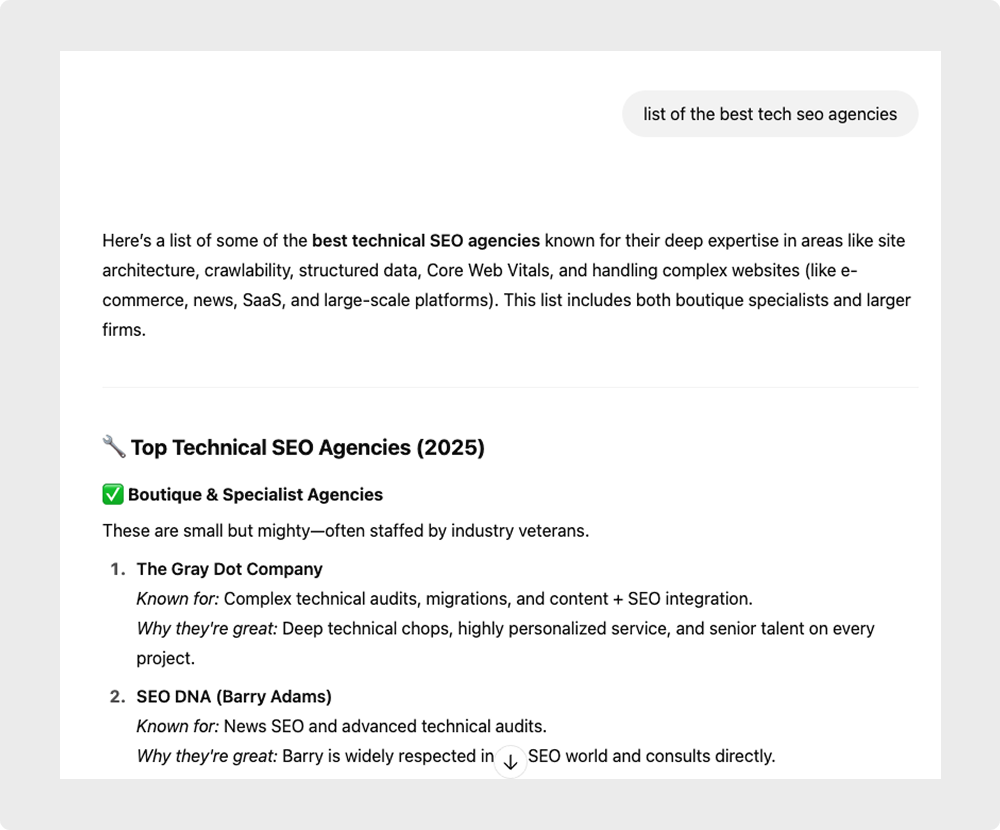
A note of caution
While frequency and relevancy may be the primary tactics for both traditional SEO and LLM optimization, the two channels are at very different points in their evolution.
15-20 years ago, SEOs were winning top rankings through spammy tactics like keyword stuffing, low-quality content at high volumes, and link-spamming blog comments and forums. Today, none of that stuff works — in fact, it hurts.
Search engines like Google have evolved in ways that are designed to protect users, identify true signals of brand authority, and recommend helpful content. Whereas today, LLMs like ChatGPT and Perplexity are still early in that journey — and those word patterns are just as easy to manipulate today as they were back then.
Unfortunately, that means that some of the spammy gamification tactics that used to work in the early days of SEO are effective at bolstering LLM visibility today.
For some brands, those types of quick wins are enticing. We’re talking about things like:
- "Best SEO agency" round-up blog posts that list your agency as number one
- Meta keywords stuffing
- White-keywords-on-a-white-background keyword stuffing
- Low-quality AI blogs & sites with keyword stuffing
- Generating numerous prompt-to-publish blog posts to round out topics on the site
At a certain point, LLMs are going to figure out how to deal with those things, just like Google did. Why? Because it creates a better user experience, which encourages people to keep using the tool.
As that happens, the brands that build for visibility the right way are going to see wins, while the spammy stuff is going to send performance off the edge of a cliff.
Which tactics grow LLM visibility?
Let’s talk about some non-spammy tactics that brands can use to grow visibility in scalable, sustainable ways.
1. Communicate your brand clearly on core pages.
Your homepage, about page, and core services pages are quintessential to communicating what your brand is and does to potential customers. In a similar way, they’re central to giving LLMs an accurate understanding of your entity.
On your homepage, make sure the following is established:
- The high-level service, product, or informational topic your brand provides to customers
- The differentiating factors that make your brand uniquely valuable
- The key value propositions that make your product or service desirable
On the about page, ensure these items are present and prominent:
- Your mission, vision, and values as a brand
- Leadership behind the brand
- How the brand was established
On product or service pages, check that these items are implemented:
- Clear descriptions of the product or service
- Why is it valuable in terms of quality, production, features, etc.?
- Reviews and testimonials
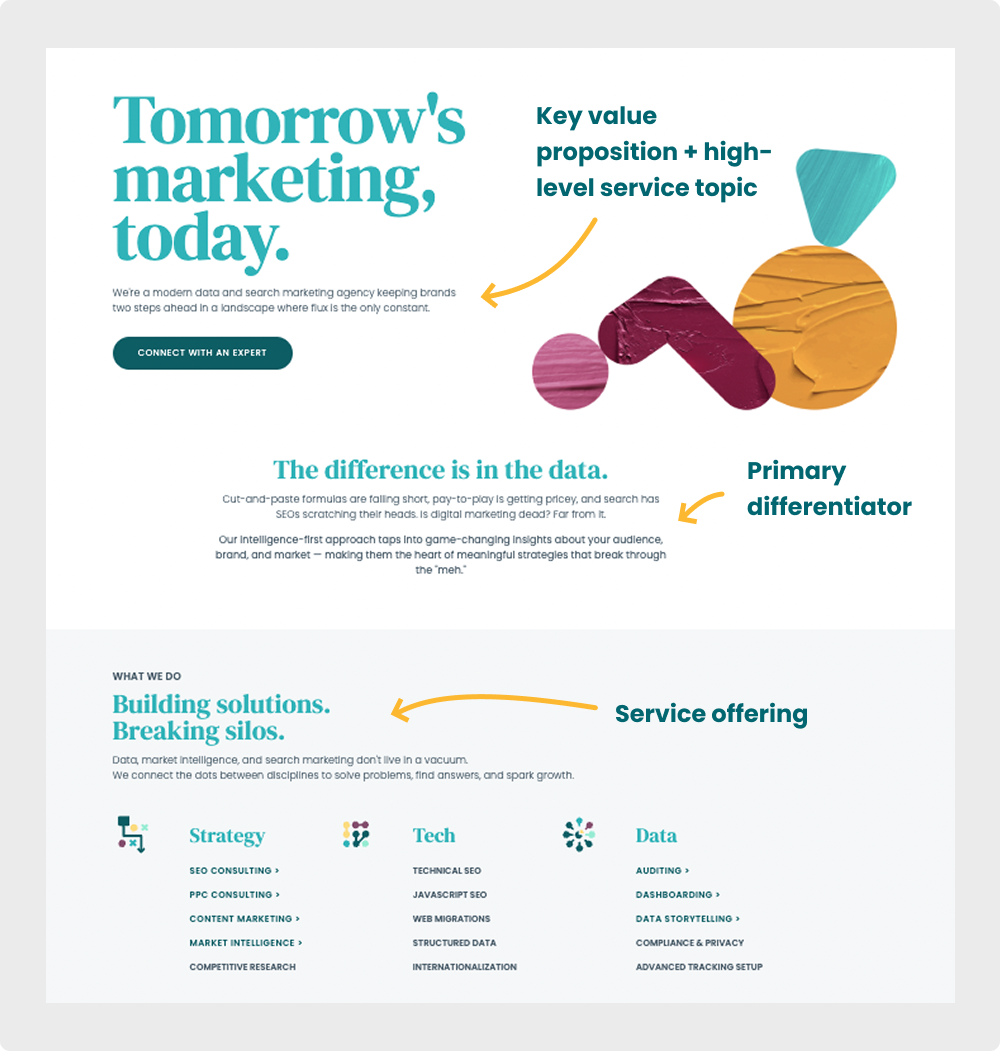
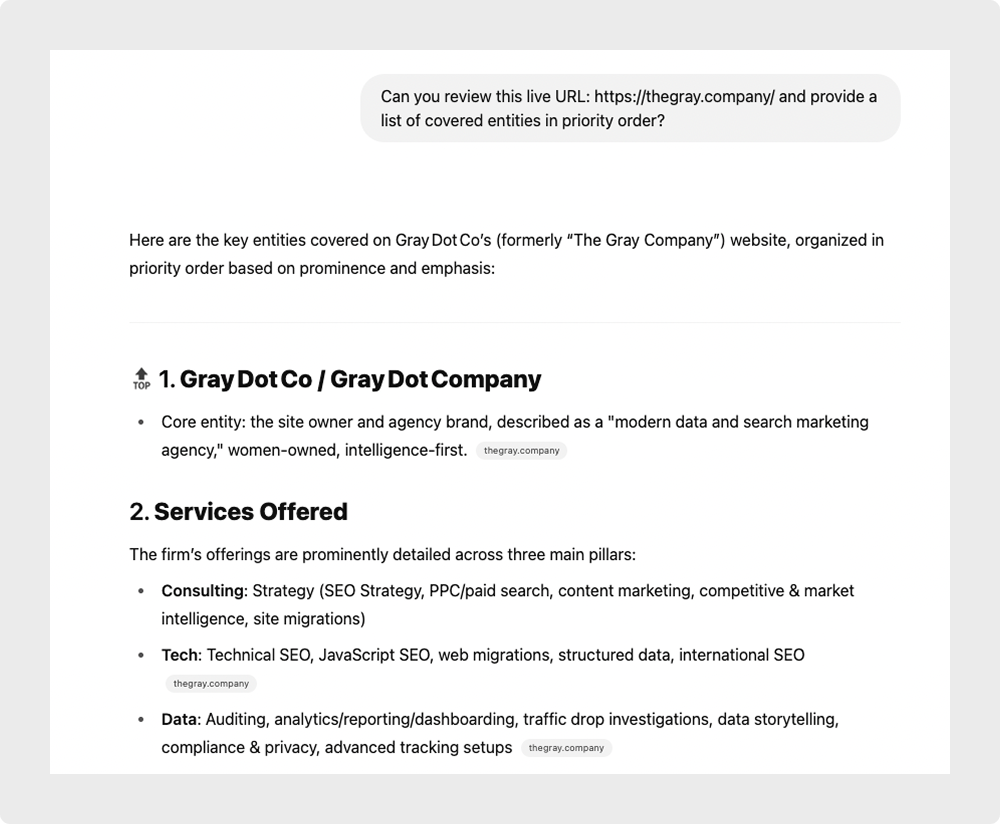
2. Publish content to support brand-relevant topics
If your brand mostly speaks to one topic - be it a product or service - then LLMs will likely assume there’s a strong semantic relationship between your brand name and that topic.
Informational, educational, and engagement-focused content are opportunities to establish clear signals about the topics that are relevant to your brand. (Again, that’s nothing new, it’s a staple of SEO.)
This is where a classic gap analysis can be useful, because finding keyword gaps is an exercise in finding topic gaps at heart.
Building content to fill the most relevant gaps ensures there’s onsite content which can help LLMs map the relationship between your brand and words/topics that you want to associate with.
However, marketers still don’t have a lot of insight into the different prompts that LLM users enter and at what frequency. What we do know is that they’re much longer on average and tend to involve many sub-queries.
If and when a LLM searches the web, it generally needs to answer several unique queries to arrive at the answer for the original user prompt. It’s called a query fan-out.
Using tools that provide insight into what the existing queries are and what their fan-outs might look like can potentially help fill the gaps.
I’m expecting that this functionality will get built into most SEO tools sometime soon.
3. Create a consistent presence across your brand profiles.
Your brand is in control of more than just onsite content. The many profiles you maintain on social media platforms, owned media, and other sites are places you can support a clear understanding of your brand.
That includes:
- Your brand’s Wikipedia page (although, this is generally more difficult than just editing your own page)
- Wikidata
- Social media (LinkedIn, Instagram, TikTok, etc.)
- Profiles on third-party marketplaces and directories (i.e. Amazon, Whitepages)
In particular, make sure to:
- At WTSFest Portland 2025, Erin Doland made the excellent point to refer to the brand in the exact same way, using the “preferred” name first and including any necessary variations as secondary references.
- ex: "The Washington Post, commonly referred to as WaPo…”
- Be consistent in how you define your brand, mentioning the core services and topics you want associated with your brand.
- “ex: Gray Dot Co is a boutique digital marketing agency connecting the dots between strategy, data, and SEO.”
4. Build brand references from other sites.
Even after you’ve created a consistent brand presence across your site and owned profiles, that’s still just a small fraction of the “training materials” available across the web.
To make a true impact on how LLMs assess the “probability” of your brand being the next word, your users, partners, publications, and even employees need to refer to it often. That means building mentions using all of the elements that go into community building and brand-awareness building (as they make sense for your brand):
- Social media - incentivize sharing and work with creators
- Earned media - get those contextual brand mentions!
- PR - including HARO, paid placements, and press releases
- Content - create strong, original content that people want to cite (studies, analyses, original data, tools, etc.)
5. Communicate in ways that make sense to users… and LLMs.
One of the most interesting frameworks for doing so comes from Everett Sizemore, who details the value of communicating in “semantic triples.”
A semantic triple is basically a statement that is expressed in the order of subject > predicate > object.
- Subject - The entity taking the action
- Predicate - The action being taken
- Object - The thing produced or impacted by the action
So an example would be “Gray Dot Co (subject) | offers (predicate) | SEO, data, and market intelligence consulting (object).”

Everett argues that this framework can create a clear communication structure that aligns with LLM reasoning. We won’t go into detail here, but he lays it all out in this article.
Big picture? Consider defining your brand’s “triple” and using it to create consistency in your entity definition. With that said, don’t use it as an excuse to “keyword stuff” content with triples! (Spam is still spam, ya’ll.)
Benchmarking & measuring LLM performance for your brand
Now that we’ve talked about the tactics that can work for growing visibility in LLM answers, let’s talk about measurement. After all, without benchmarks and data, we can’t understand what’s working or when. (And we certainly can’t connect the dots to “why!”)
Brand entity
How do LLMs define your brand, and in turn, communicate it to users?
Benchmarking
The best way to find out how LLMs contextualize and define your brand entity is to ask them. Generally, you’ll want to repeat this exercise across multiple, major LLMs. For the sake of example, we’ll show you how to audit your entity on ChatGPT.
Search for your brand. Here’s what it generated for the prompt “What is Gray Dot Co?”
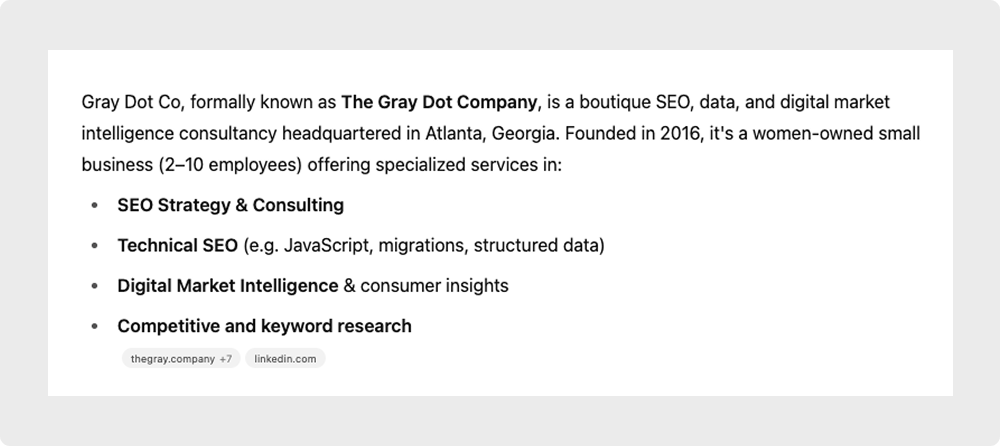
- It understands that Gray Dot Co and The Gray Dot Company (our original brand name) are the same thing.
- While data is mentioned in the first sentence, it’s not represented in the bulleted service items. (Maybe data services are not emphasized enough on our site and in referrals?)
- “Competitive and keyword research” are specific services that nest a level deeper in our portfolio than the other items in the list. (Maybe these items are getting too much emphasis?)
The nice thing is, this will also give you a good idea of which sites ChatGPT is leaning on to generate the answer.
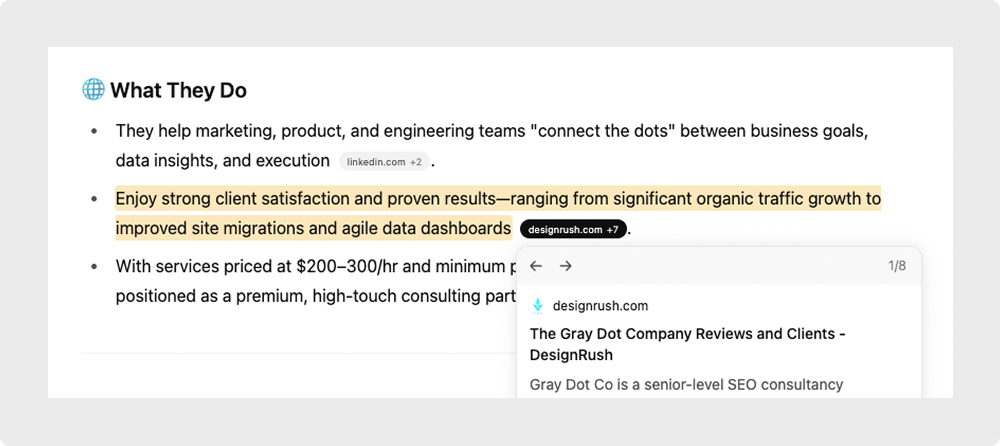
Now we have three actionable tactics that we can implement to further refine our brand entity:
- Update the verbiage on our LinkedIn profile.
- Encourage clients to leave reviews about their experience with us.
- Explore if updating directory listing data is an option.
Ongoing measurement
As you make optimizations to refine your entity across LLMs, you want to make sure they’re working.
That’s really just a matter of repeating this exercise on a regular cadence. Then compare to your benchmark and any previous iterations.
The frequency of this exercise depends on the LLMs you’re checking.
If an LLM is using training data, it’s only updating periodically. We don’t inherently know how often they’re ingesting updated data.
If the LLM is using live web data or user-feedback data, it will update much faster than if it were using training data alone.
Most tools and queries default to using training data, because there are costs to updating more frequently than you need to.
Finding the right cadence is a matter of researching each LLM to understand which queries it’s answering using which sources. Realistically, auditing your entity definition once a quarter should suffice.
LLM Rankings
Which prompts do we show up for and at what ranking*?
*Before we get into this, a short caveat: LLMs don't exactly do "rankings". A brand's presence in results is dependent on several factors including but not limited to word probability, a user's stated use cases, and personalization/a user's context window (e.g. previous prompts while logged in to the same tool).
A "probability score" of brand visibility is likely a better proxy for measurement in an AI world. This said there's no major tool that provides a way to do this today.
Until better measurement protocols become available, the following offers a benchmarking and ranking workaround.
Benchmarking
This is certainly something you can do manually by entering prompts one by one. In which case, it’s worth asking ChatGPT what some of the most commonly used prompts are.
Ironically, there’s no telling if they are real user queries (in anything, that's unlikely!) or the frequency at which they’re used. Still, the information is directionally helpful for unearthing the types of queries you can optimize around.
I’ll use Blueland cleaning products as an example, since they’re a new but popular company in a specific niche of an established market (eco-friendly cleaning products). So it might yield some interesting results.
To get prompt ideas, I could ask ChatGPT for the prompts people are most likely to use when looking for eco-friendly cleaning product recommendations. Then, search for each of those prompts.
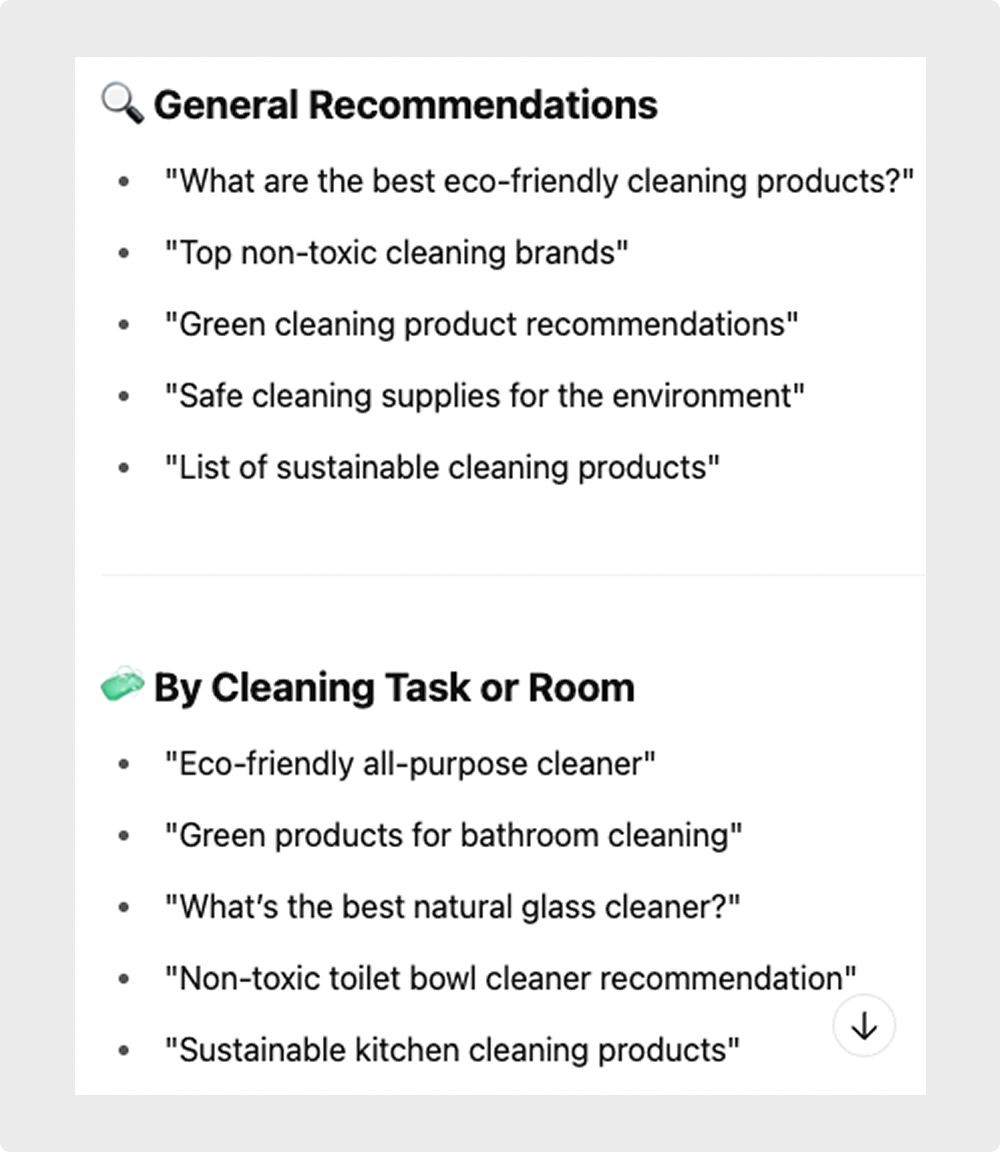
It’s important to understand that the prompts third-party tools analyze are shorthand assumptions about the sorts of things users might be searching for. Real queries tend to be HIGHLY tailored and personalized.
We’re not aware of any tools today that provide query or volume data. Tools in the current moment are really just sources of rough guidance rather than data to take as gospel. (But isn’t an imperfect tool better than no tool? 🤔)
So with that being said, here’s how we use the Fractl Agents tool:
1. Under LLM Rankings, go to “Rank Tracking,” and set up a "New Ranking Check".
2. Choose the keyword queries that should be used for narrowing down the most relevant prompts.
To start, I recommend generating the keyword set via LLMs. You can and absolutely should use the user-provided version, too, but the default will tell you:
- What LLMs think are useful queries for your brand, which is interesting data in itself.
- How to structure what your "keyword queries" should be.
It’s worth noting the original prompt recommendations we gathered from ChatGPT are likely worth including as part of your keyword set.
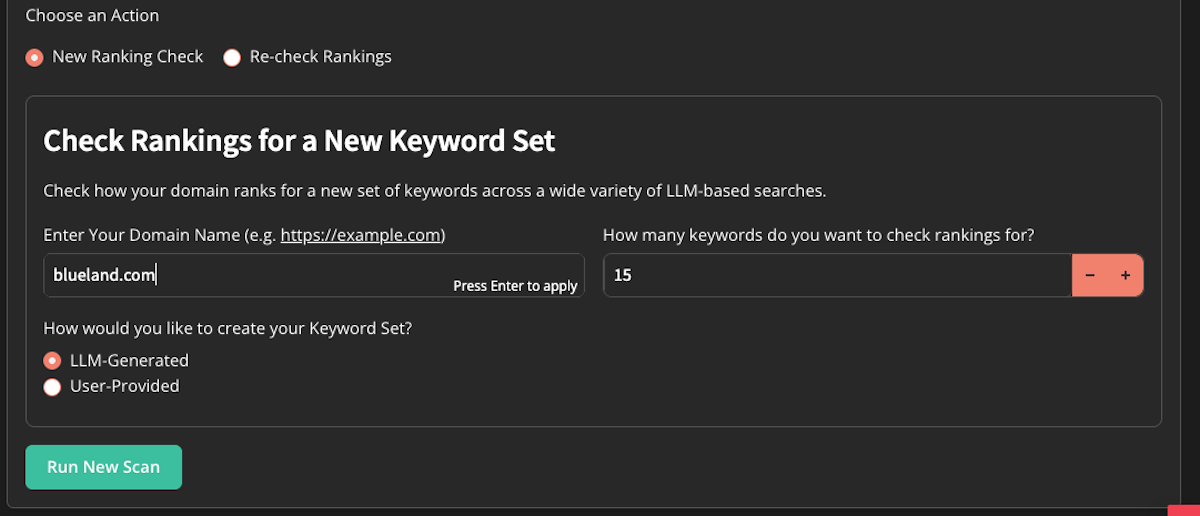
The tool runs these queries on several different models, telling you if your brand ranks, and if so, at which place.
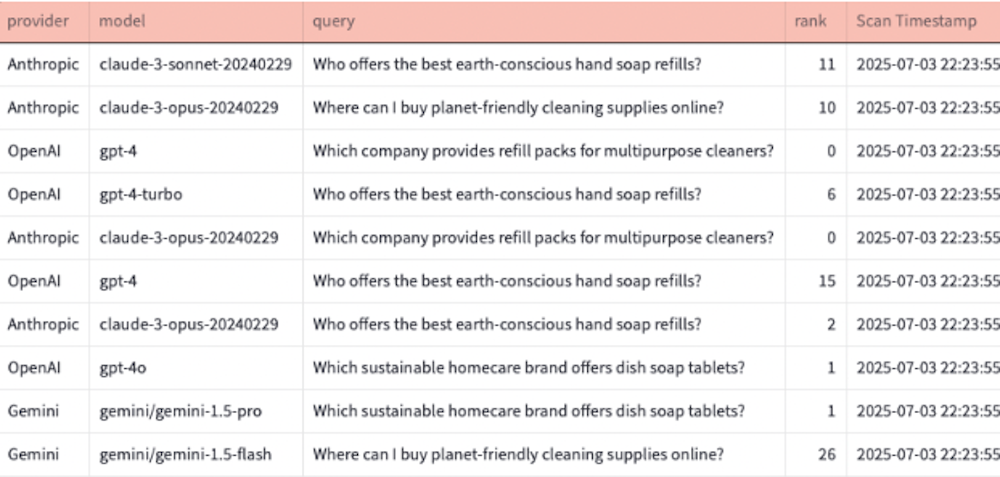
Ongoing measurement
Really, this is your classic marketing rinse-and-repeat step. Alter or add to your queries over time, ensuring that you’re tracking the right ones.
Pull the data at regular intervals - probably monthly - to compare how rankings are changing based on your efforts to grow visibility.
Keep track of the rankings for the same queries over time, so you can compare progress. A monthly check should be adequate for most brands.
Brand KPIs
The final piece of measuring LLM visibility is likely the most important: measuring the impact of that visibility on your business. That includes traffic, revenue, and other business-critical metrics tracked in your default analytics tool.
Here are a couple of resources you might find useful.
Getting data into GA4
On LinkedIn, Jes Scholz breaks down how to track LLM users in GA4. You can also find her original post and directions below.

- Create an exploration in GA4.
- Set "page referrer" as the dimension.
- Set "sessions" as the metric.
- Apply the filter below.
^https:\/\/(www\.meta\.ai|www\.perplexity\.ai|chat\.openai\.com|claude\.ai|chat\.mistral\.ai|gemini\.google\.com|bard\.google\.com|chatgpt\.com|copilot\.microsoft\.com)(\/.*)?$
Note: You’ll want to update the list in the filter over time as new LLMs come into the fold.
Creating a Looker Studio dashboard
Viola Eva has shared a dashboard template that compares KPIs from traditional organic search to those from LLMs.
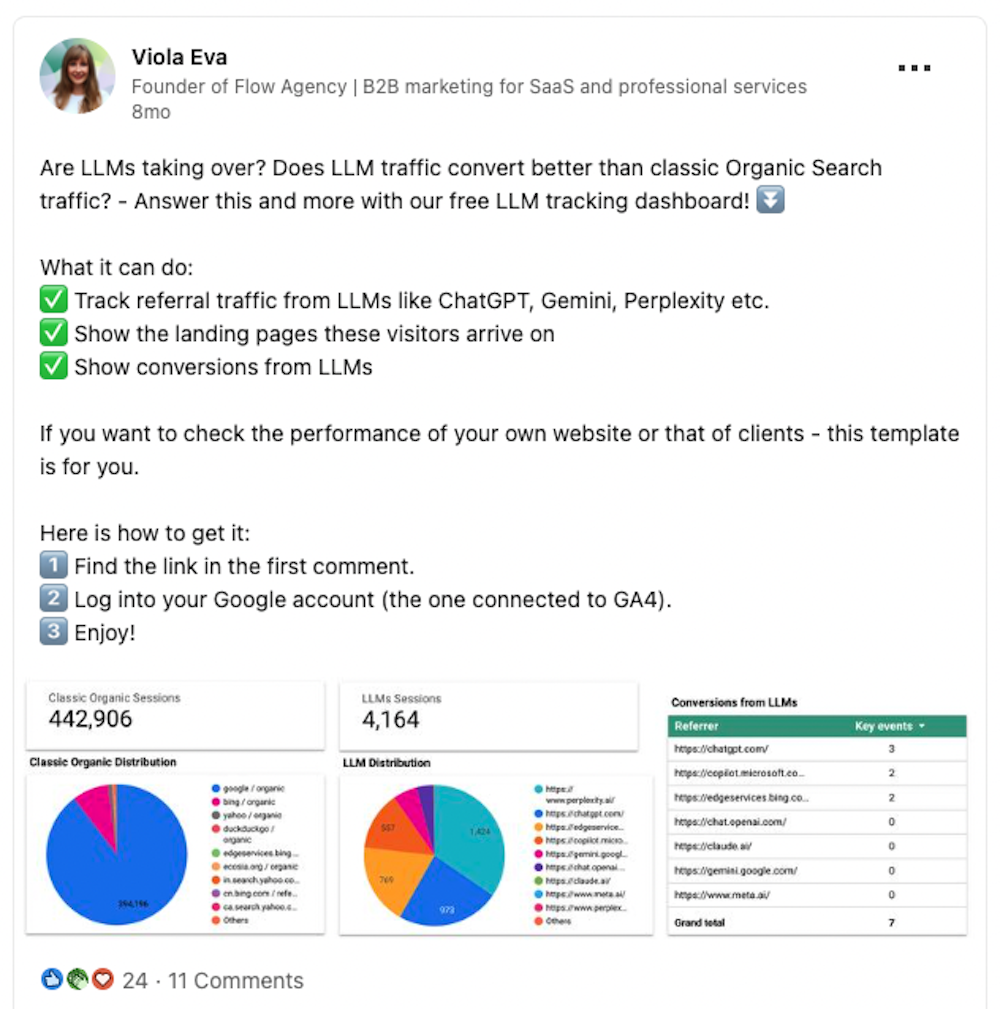
Remember: The shift isn’t seismic, it’s speculative.
Yes, it can be tempting to buy into all the fervor around the “future of search.” Right now, the value of LLM visibility as part of the marketing mix is largely speculative. And we’re certainly not at a place where we should focus on AEO instead of SEO.
We don’t know how big this is going to be. But what we do know is that there are smart tactics that can help set brands up for success, while ultimately being a net-positive no matter what happens.
Focus on sustainable, non-spammy tactics - prioritizing those that also benefit critical marketing channels - and gather data for educated decision-making. No matter what the new frontier brings, it’s probably going to stay true to what we’ve seen in the world of search to date.
Brands that build the right way win out in the long run.

